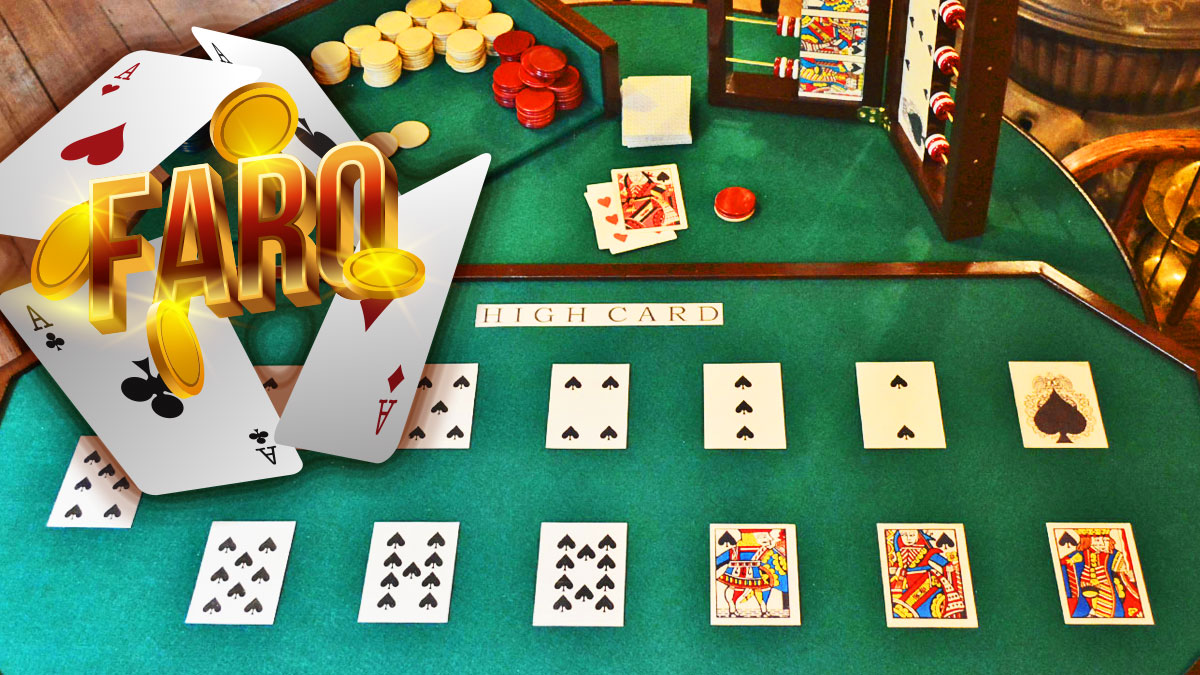Some casino games have survived centuries and still remain quite popular. Blackjack and roulette are two great examples of this fact.
Other games, however, don’t survive the test of time. For one or more reasons, they fall out of favor with the gambling community and eventually disappear from casinos.
Faro is a once-famous card game that used to be quite popular in the American and European game scene. But today, it has completely vanished from casinos.
Why is Faro now long forgotten? I’m going to discuss the basics of this game along with its rise and fall in the gaming industry.
Basics of Faro
Faro is played with a standard 52-card deck and additional cards that represent the game’s layout. The layout features 13 cards of the same suit (two through ace).
For Example:
The dealer might layout two through ace of spades. The card values or ranks are important here, not the actual suit, similar to real money blackjack.
Your goal is to bet on the winning card rank. If you put chips on five, for example, then you need the dealer to draw a five to win. You’re allowed to wager on multiple cards in each round if desired. For instance, you might place chips on three, seven, and king.
Each round begins with the dealer placing the 52-card deck into a dealing box. The dealing box is supposed to ensure that the deck is properly mixed in between rounds.
The first card out of the box is called the “soda,” and it gets burned. Next, the dealer draws two more cards—the banker and player cards.
Bettors who laid chips on the banker card automatically lose. Gamblers who laid chips on the player card automatically win a 1:1 payout.
Players can also make a high card wager. Assuming the player’s card is higher than the banker’s card, they win. Bets that push remain on the board. Players can either leave the chips where they stand, put them on another card, or remove them from the board altogether.
Early Beginnings of Faro
Faro is based on an old French card game called Pharaon (French for “Pharaoh”). Invented in Southwest France during the reign of Louis XIV, Pharaon became extremely popular after Basset (another card game) was banned in 1691.
With Basset no longer an option, more gamblers rushed to play Pharaon. The latter became quite popular throughout France and beyond as a result.
Pharaon, however, would eventually join Basset in being banned, too. Nevertheless, underground gambling houses continued offering both Pharaon and Basset.
The English quickly adopted Pharaon as well and shortened the name to Pharo. In a 1752 letter addressed to Parliament member George Selwyn, writer Gilly Williams mentioned how many English gamblers felt that Pharo was the best gambling game in the country.
The American Faro Boom of the 1800s
This card game didn’t stay confined to Europe for long. It eventually made its way to the United States in the 19th century.
Americans began referring to the game as Faro. The first players likely misinterpreted the spelling of the English version called “Pharo.”
Much like it had become a hit in England and France, Faro quickly caught fire in the US as well. It was available everywhere from Old West towns to Washington DC.
The latter actually featured Faro in over 150 gambling houses in the mid-1800s. Research at the time showed that this game was by far the most popular among gamblers.
Some Americans began calling the game “bucking the tiger.” This name refers to the common mid-19th century card-backs, which featured a Bengal tiger.
Faro was so dominant throughout the US that popular city gambling districts became known as “tiger town.” Although these same districts offered other games, Faro was so popular that it always took center stage at the time. Many gambling houses would even hang a tiger picture outside to let players know that Faro was available.
Why Did Faro Boom?
This game was far from the only option available at mid-1800s gaming establishments. Baccarat, blackjack, roulette, and street craps were also fairly popular back then.
However, many gamblers felt that Faro offered the perfect mixture of simple rules, excitement, and great odds. It also helped that tables could theoretically seat an unlimited number of players.
Gamblers didn’t have to risk much to join the action either. Many tables accepted minimum wagers as low as a penny.
Faro simply became the game to play. It was the unofficial national gambling past time in the US, England, France, Germany, and several other European countries.
Anti-Gambling Movement and Cheating Hurt Faro
Faro became a victim of its own success. Its rapid rise and growing popularity drew a number of critics. The latter pointed out how this game created many gambling addicts and was rife with cheating.
Of course, any highly popular form of gaming will attract its share of problem players. But the cheating elements couldn’t be ignored.
Gambling venues started cheating their customers by rigging the shoe. The situation got so bad that equipment manufacturers actually began producing pre-rigged dealing boxes.
Hoyle issued warnings to Faro players in their packs. Their Faro section made gamblers aware that they were dealing with a potentially crooked game.
Luckily, some of these gambling establishments were eventually prosecuted for their crimes. But the damage to the game had already been done.
By the time World War II broke out, few people were playing Faro. It eventually became a rare game that was only offered in major casino destinations like Las Vegas and Reno.
Rise of Poker
Cheating revelations weren’t the only aspects that damaged Faro in the mid-19th century. The rise of poker also began to cutting into its popularity.
The exact origins of poker are unknown. However, it’s well documented that many gamblers began playing it on Mississippi riverboats in the mid-1800s.
Like Faro before it, poker also offers a great blend of basic gameplay and excitement. It comes with the added benefits of featuring in-depth strategy.
The latter allows players to gain an edge over their opponent. If one becomes good enough at poker, they can make serious profits.
Poker also featured a better reputation at the time. While dealers can cheat in this game, too, scamming never became as widespread in poker as it is with Faro.
Faro Completely Vanishes in the 1980s
Once the toast of the US and European gambling scene, Faro was standing on its last legs by the mid-20th century. Fewer and fewer casinos were offering this game.
By this point, the cheating elements have been largely removed. Regions with legal gambling launched governing bodies, which monitored casinos to ensure that they didn’t cheat players.
Even still, Faro was dying a slow death. It lost even more popularity as video slot machines began demanding more players’ attention in the 1970s. It still maintained a small place on gambling floors in Vegas and Reno, but it was seldom found elsewhere.
Even these major gaming destinations finally had enough. In the 1980s, Reno became the last place to finally phase out Faro.
Conclusion
Faro is a long-forgotten chapter in European and American gaming history. Most gamblers today have never even heard of it.
But less than two centuries ago, it was once the dominant form of gambling across Europe and the US. People flocked to wager on this simple, yet exciting, game.
Cheating started the downturn of Faro, though. Gambling houses broke the trust of their players by using rigged decks. Their actions still form the roots of every fear that gamblers have about being cheated by casinos today.
Poker put another big dent in Faro’s popularity. It quickly spread from Mississippi riverboats to underground casinos at a time when Faro suffered from an image problem.
Even with these issues, Faro still survived in casinos on a limited basis. But it finally faded away for good, though, when Reno stopped offering it in the 1980s.
Michael Stevens
Michael Stevens has been researching and writing topics involving the gambling industry for well over a decade now and is considered an expert on all things casino and sports betting. Michael has been writing for GamblingSites.org since early 2016. …



